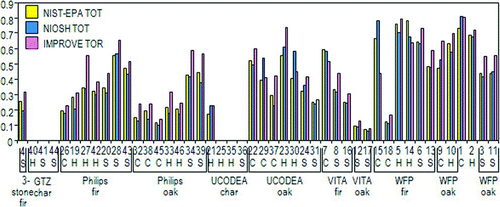Figures & data
FIG. 1 Typical NIOSH TOT thermogram. The split point is determined from the laser absorbance in the He-Ox phase to the initial absorbance in the He phase (designated as horizontal dashed line). Char production is defined by attenuation of the laser signal and char evolution defined by the increase in the laser signal prior to EC evolution. FID1 (solid line)–-carbon species at 100% signal, FID2 (dotted line)–-carbon species at 25% signal, laser transmission (solid line), and temperature protocol (dashed line) (color figure available onlne).

TABLE 1 Temperature protocols for the 3 methods
TABLE 2 Total carbon measurements for NIST-EPA, NIOSH, and IMPROVE protocols. There was no difference for TC between TOT and TOR for the individual protocols
TABLE 3 Cookstove/fuel/phase combinations
TABLE 4 The percent range and average OC/EC ratios for the 3 temperature protocols using optical transmission (TOT) and reflectance (TOR) for char correction. The optical (p value) t-test statistic compares between TOT and TOR for each protocol for each sample type. The thermal (p value) ANOVA-test statistic compares the different temperature protocols within an optical correction method (transmission or reflection). The p values <.05 are significantly different (shown in bold).
TABLE 5 The percent range and average EC/TC ratios for the 3 temperature protocols using optical transmission (TOT) and reflectance (TOR) for char correction. The optical (p value) t-test statistic compares between TOT and TOR for each protocol for each sample type. The thermal (p value) ANOVA-test statistic compares the different temperature protocols within an optical correction method (transmission or reflection). The p values <.05 are significantly different (shown in bold)
FIG. 2 EC/TC ratios for the different cookstove/fuel/WBT combinations for the conventional methods (NIST-TOT, NIOSH TOT, and IMPROVE TOR) (color figure available onlne).
